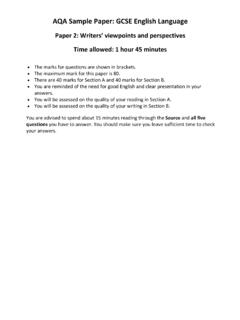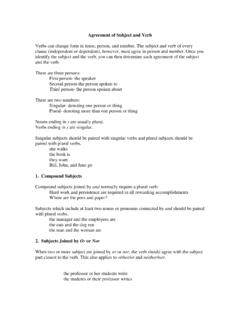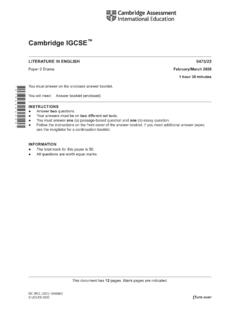Transcription of Noughts & Crosses by Malorie Blackman: a textual analysis
1 1 Noughts & Crosses by Malorie Blackman: a textual analysis The essay below explores a short extract from Noughts and Crosses by Malorie Blackman. A critical analysis will demonstrate aspects of historical context, ideology of the author, concepts of childhood, stylistic devices used, narrative voice, devices conveying mood and character, themes and how the scene moves the story forward. Noughts and Crosses presents a key historical context in terms of the reader being immediately presented (with) issues of race (Wilkie-Stibbs, 2006, ). He was with his dagger friend Jude smirked. ( Noughts and Crosses , ) Jude (Callum s brother) makes a racial remark against the Crosses who are depicted as being black within the book. Throughout history there have been issues of racism not only between black and whites but between other minority groups.
2 Blackman states she wanted to tackle the subject of racism head on but also has burning anger (..) regarding the death of Stephen Lawrence and the (..) mishandling of the police inquiry into his death (Blackman, 2001, ). From this it is evident Blackman wanted to expose racism and the effects on children as a lesson to society. The ideology of the author is very clear. Blackman wanted to show the effects of racism, class and cultural issues in society, which had had a personal effect on Blackman herself as it grew out of a lifetime of experiences (Blackman Interview, 2013). Looking at our hovel, I could feel the usual burning, churning sensation begin to rise up inside me. Blackman s ideologies are expressed through Callum s feelings about his own house.
3 The use of the word hovel allows the reader to see Callum s harsh opinions of his home and also the jealousy he had towards the mansion Sephy lives in. The amplification of the words burning and churning expresses Callum s very strong emotions at the time. This could represent the same feelings Blackman herself felt as she states in an interview some of the racist incidents in the book were based on real events from my own childhood (Blackman Interview, 2013). Blackman expresses explicit concepts of childhood through the use of compassion from Callum s mum, in comparison to his father not being interested in Callum. Where ve you been Callum? I was worried sick 2 Dad wasn t bothered about me or anything else for that matter Blackman explicitly uses classic concepts of family.
4 As Reynolds (2011, ) states childhood takes place in families . In Noughts and Crosses , Blackman presents Callum s family, as the idealised nuclear family (Alston, 2008, ), however not always loving. Callum s mother is a compassionate and caring woman, which is portrayed through the use of direct speech stating she was worried about where he had been. His father on the other hand, is shown as the less caring parent. Not only does he not care about his son, Callum, but also Blackman restates he does not care about anything else either. Blackman s childhood for Callum, is one of love and care from his mother and one of friction between family members portrayed by the friction between Callum and his irritating toad brother Jude. Blackman implicitly reinforces implications of race through Callum s childhood and his personal desire to be better.
5 The only thing that was worth a damn was the oaken table. Years before, Dad had cut and shaped it and carved the dragon s leaf pattern into it, put it together and polished it himself. Sephy s mother had once tried to buy it but Mum and Dad wouldn t part with it. Callum s strong desire to be more like the Crosses and be better in society is expressed throughout the passage. The above quote makes it hard for the reader to not engage in an emotional attachment towards Callum. Callum s childhood is shown as one of worry and anger about not being upper class, evident through his tone of voice when discussing the only thing that was worth a damn was the oaken table . The sound of disgust is very apparent. Blackman shows the concepts of childhood as complex and perhaps reinforces family in childhood through the symbolic nature of the hand carved table.
6 Moreover, Blackman portrays the irony of Sephy s mother wanting to buy the table buying something from a Nought! Callum s passion to be upper class and like the Crosses is implicitly reinforced. He undervalues the table and is unable to see the value of the item. In childhood, the reader would be shocked by Callum s worry about being lower class. Stylistic devices include the use of metaphor emphasising Callum s state of mind and the idea of being alone. I watched a solitary cloud slowdance above me, watched a sparrow dart and soar without a care in the world. The metaphorical use of clouds slowdancing, allows the reader into Callum s state of mind. The words solitary can be a direct symbolism of Callum himself; existing alone. The sparrow flying without a care in the world , can represent how Callum would like to be at the time.
7 Blackman s use of the 3 metaphor reinforces the idea of being alone, not just Callum being alone but all the Noughts set in a world where dark skin is considered racially superior to white (Flanagan, 2011, ). In the extract from Noughts and Crosses the narrative voice is portrayed through the deeply personal first person account of Callum, the protagonist. I closed my eyes and took a deep breath. Steeling myself, I pushed open the front door and walked inside. The use of a first person is evident through the words I throughout the extract. By using the words I allows the reader to relate more with the story, in this instance Callum. The narrative voice also has a fast pace, seen above with short sharp sentences, which allows the intensity to grow for the reader.
8 The pace also represents life, Callum s life. In an interview with Malorie Blackman, she expresses Callum s personality is probably closest to my own (Blackman Interview, 2013). With this in mind, the reader is able to hear the voice of Blackman through Callum as a character. Blackman uses several devices such as tone, setting and diction to create the mood through the extract and Callum s character. I live in a palace with golden walls and silver turrets and marble I opened my eyes and looked again at my house. My heart sank. I closed my eyes again. Blackman uses setting to create the mood through the extract. Callum is dreaming about living in a palace with golden walls and silver turrets and marble floors , it is evident for the reader the setting is idyllic, materialistic (Rudd, 2010, ) and as the sentence is read, the reader is able to picture the disappointing house Callum lives in.
9 However, this is short lived as again the fast paced sentences, present the tone of Callum s character. Then with the use of diction, the words My heart sank shatters any hope and desire the reader feels towards Callum s home. Evidently he does not live in an idyllic home and this evokes sympathy towards Callum. Blackman goes against Reynolds (2011, ) standard optimistic children s book, with a more depressive (Reynolds, 2011, ) outlook. The themes portrayed within the extract show Blackman tackling the difficult issues of cultural dominance (Book Reviews, 2004, ), race, class and romance. Why didn t any nought I knew of live in a house like Sephy s? Blackman cleverly uses cultural dominance alongside class. Cultural dominance is evident from Callum s question asking why Noughts are unable to live in a house like Sephy s a cross.
10 Sephy s house is represented as the domineering class in comparison to Callum and the Noughts . Another theme 4 represented is race, through the words of Noughts and Crosses . Callum represents an individual who wants his own race to be on the same level as Sephy s. He wants them to be able to live in a house like Sephy s . An implicit theme is the romance between Callum and Sephy, although not represented in this passage of the book, the reader can already identify Sephy is key to Callum s life. Blackman is able to use romeo and juliet style romance to show the complexity of relationships between two different cultures (Book Reviews, 2004, ). The prior scene is explored through the protagonist Sephy, whereas the extract being explored is from the view of the protagonist Callum.



